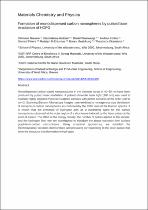 ResearchSpace
ResearchSpace
Formation of monodispersed carbon nanospheres by pulsed laser irradiation of HOPG
JavaScript is disabled for your browser. Some features of this site may not work without it.
- ResearchSpace
- →
- Research Publications/Outputs
- →
- Journal Articles
- →
- View Item
| dc.contributor.author |
Mouane, O

|
|
| dc.contributor.author |
Sideras-Haddad, E

|
|
| dc.contributor.author |
Wamwangi, D

|
|
| dc.contributor.author |
Forbes, A

|
|
| dc.contributor.author |
Peters, G

|
|
| dc.contributor.author |
Erasmus, RM

|
|
| dc.contributor.author |
Mwakikunga, Bonex W

|
|
| dc.contributor.author |
Gkanetsos, T

|
|
| dc.date.accessioned | 2021-04-12T14:04:45Z | |
| dc.date.available | 2021-04-12T14:04:45Z | |
| dc.date.issued | 2020-10 | |
| dc.identifier.citation | Mouane, O., Sideras-Haddad, E., Wamwangi, D., Forbes, A., Peters, G., Erasmus, R., Mwakikunga, B.W. & Gkanetsos, T. et al. 2020. Formation of monodispersed carbon nanospheres by pulsed laser irradiation of HOPG. <i>Materials Chemistry and Physics, 253.</i> http://hdl.handle.net/10204/11978 | en_ZA |
| dc.identifier.issn | 0254-0584 | |
| dc.identifier.issn | 1879-3312 | |
| dc.identifier.uri | https://doi.org/10.1016/j.matchemphys.2020.123269 | |
| dc.identifier.uri | https://www.sciencedirect.com/science/article/pii/S0254058420306398 | |
| dc.identifier.uri | http://hdl.handle.net/10204/11978 | |
| dc.description.abstract | Monodispersed carbon-based nanostructures in the diameter range of 40–50 nm have been produced by pulsed laser irradiation. A pulsed ultraviolet laser light (308 nm) was used to irradiate Highly Oriented Pyrolytic Graphite surfaces with power densities of the order 108 W cm−2. Scanning Electron Microscope images have exhibited a homogenous size distribution of amorphous carbon nanospheres as confirmed by the ID/IG ratio of the Raman spectra. It is shown that the presence of hydrogen acts as a nucleating agent for the carbon nanospheres observed at the outer region of a shockwave induced by the laser pulses at the point of impact. The effect of the energy density, the number of pulses applied to the sample, and the hydrogen flow rate are investigated to elucidate the phase transition from surface graphite-to-carbon nanospheres. Using analytical approaches, we establish the thermodynamic variables (temperature and pressure) corresponding to the laser pulses that drive the structural transformation in hydrogen. | en_US |
| dc.format | Abstract | en_US |
| dc.language.iso | en | en_US |
| dc.source | Materials Chemistry and Physics, 253 | en_US |
| dc.subject | Carbon nanospheres | en_US |
| dc.subject | HOPG nano-Structuration | en_US |
| dc.subject | Pulsed laser ablation | en_US |
| dc.subject | Shockwaves | en_US |
| dc.title | Formation of monodispersed carbon nanospheres by pulsed laser irradiation of HOPG | en_US |
| dc.type | Article | en_US |
| dc.description.pages | 10pp | en_US |
| dc.description.note | © 2020 Elsevier B.V. All rights reserved. Due to copyright restrictions, the attached PDF file only contains the abstract of the full text item. For access to the full text item, please consult the publisher's website: https://www.sciencedirect.com/science/article/pii/S0254058420306398 | en_US |
| dc.description.cluster | Chemicals | en_US |
| dc.description.impactarea | NS Materials for Sensing App | en_US |
| dc.identifier.apacitation | Mouane, O., Sideras-Haddad, E., Wamwangi, D., Forbes, A., Peters, G., Erasmus, R., ... Gkanetsos, T. (2020). Formation of monodispersed carbon nanospheres by pulsed laser irradiation of HOPG. <i>Materials Chemistry and Physics, 253</i>, http://hdl.handle.net/10204/11978 | en_ZA |
| dc.identifier.chicagocitation | Mouane, O, E Sideras-Haddad, D Wamwangi, A Forbes, G Peters, RM Erasmus, Bonex W Mwakikunga, and T Gkanetsos "Formation of monodispersed carbon nanospheres by pulsed laser irradiation of HOPG." <i>Materials Chemistry and Physics, 253</i> (2020) http://hdl.handle.net/10204/11978 | en_ZA |
| dc.identifier.vancouvercitation | Mouane O, Sideras-Haddad E, Wamwangi D, Forbes A, Peters G, Erasmus R, et al. Formation of monodispersed carbon nanospheres by pulsed laser irradiation of HOPG. Materials Chemistry and Physics, 253. 2020; http://hdl.handle.net/10204/11978. | en_ZA |
| dc.identifier.ris | TY - Article AU - Mouane, O AU - Sideras-Haddad, E AU - Wamwangi, D AU - Forbes, A AU - Peters, G AU - Erasmus, RM AU - Mwakikunga, Bonex W AU - Gkanetsos, T AB - Monodispersed carbon-based nanostructures in the diameter range of 40–50 nm have been produced by pulsed laser irradiation. A pulsed ultraviolet laser light (308 nm) was used to irradiate Highly Oriented Pyrolytic Graphite surfaces with power densities of the order 108 W cm−2. Scanning Electron Microscope images have exhibited a homogenous size distribution of amorphous carbon nanospheres as confirmed by the ID/IG ratio of the Raman spectra. It is shown that the presence of hydrogen acts as a nucleating agent for the carbon nanospheres observed at the outer region of a shockwave induced by the laser pulses at the point of impact. The effect of the energy density, the number of pulses applied to the sample, and the hydrogen flow rate are investigated to elucidate the phase transition from surface graphite-to-carbon nanospheres. Using analytical approaches, we establish the thermodynamic variables (temperature and pressure) corresponding to the laser pulses that drive the structural transformation in hydrogen. DA - 2020-10 DB - ResearchSpace DP - CSIR J1 - Materials Chemistry and Physics, 253 KW - Carbon nanospheres KW - HOPG nano-Structuration KW - Pulsed laser ablation KW - Shockwaves LK - https://researchspace.csir.co.za PY - 2020 SM - 0254-0584 SM - 1879-3312 T1 - Formation of monodispersed carbon nanospheres by pulsed laser irradiation of HOPG TI - Formation of monodispersed carbon nanospheres by pulsed laser irradiation of HOPG UR - http://hdl.handle.net/10204/11978 ER - | en_ZA |
| dc.identifier.worklist | 24323 | en_US |





